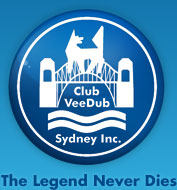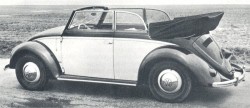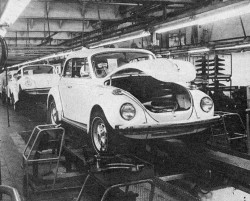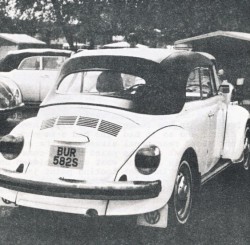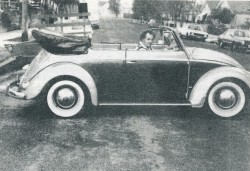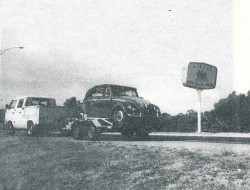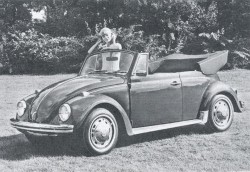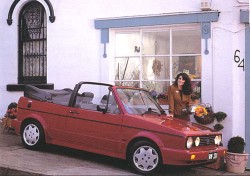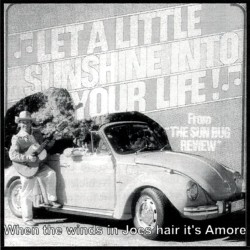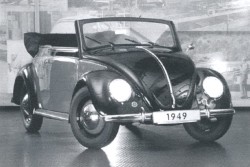Cabriolets
The Evolution of the Convertible
End of the (Assembly) Line
Club VW Cabrios
A Breath of Fresh Air
Golf Cabrios
The joys and frustrations of owning a Vee Dub
25 years since Beetle Cabriolet
The Evolution of the Convertible
By Natalie Driscoll
April 1988
Nowadays it is practically impossible to find out how many convertibles were produced up to the end of 1945. It must have been a very small number!
The first VW-type convertible was designed in 1931 by Dr. F. Porsche. It was a cabriolet version of the early Porsche Type 12 ‘people’s car’ prototype. There were two saloon versions, which were very streamlined in appearance compared to that of the cabrio, which was more angular and upright looking. It was developed for Herr Neumeyer who was head of Zündapp, a large motorcycle manufacturer, during 1931. Although the cabrio was tested, it became evident that the market was not quite ready for such a design.
NSU displayed interest in Porsche’s small car theme, and gave him the go-ahead for further development of the saloon versions, not the Cabrio. After NSU lost interest, it was up to Porsche’s design office to keep it going with the development of later prototypes, the V1 and the V2 (no, not the WW2 rockets). Both with experimental engines, they were tested in February 1936 by the RVA (the Association of German Vehicle Builders). They were not impressed but agreed to give Porsche more time. He came up with three proper prototypes, the V3 series, though not including Porsche’s dream convertible.
Successful testing of the series 3 resulted in the series 30 – a larger version, built by Daimler Benz in 1937 – all sedans! In 1938 three of the cars were shown to the public in their final form; among them was a convertible. A replica of this car is now in Wolfsburg’s Volkswagenwerk museum.
During the next few years, as the political situation got worse, the entire emphasis was changed and Porsche’s convertible was once again more or less forgotten. More interest was being generated in other areas at the time, such as Kübelwagen and Schwimmwagen and other military projects. Nothing to do with civilian VWs at all.
In the post-war period it was up to the British authorities to pick up the pieces from the once-great factory. Among a list of interesting things that they uncovered were two convertible Beetles. A Type 15, basically the same design as the pre and mid-war days. The other a Type 55, similar in design but mounted on a Kübelwagen chassis. These two, though, never made it off the production line.
Various convertibles were built from spare parts in 1946, but only on a one-off basis. In 1948 big changes took place at Wolfsburg, with the Germans once again taking control with Heinz Nordhoff at the helm. He gave orders to two body manufacturers of the time to develop two types of convertibles. These were the luxury two-seater, known as the Hebmüller, and the four-seat Beetle Karmann Cabrio.
Problems such as sealing were encountered, and another major problems was the loss of rigidity when the roof was cut off. This problem was solved by running two steel channels on either side of the chassis. With a bit more work and testing, the car was finally accepted and was labelled the Type 15 (Type 151 for left-hand drive, 152 for right-hand drive).
At the time, and similarly 30 years later, the Beetle Cabriolet was a more luxurious version of its sedan counterpart. The hood when closed became completely watertight and virtually airtight, offering complete protection for its passengers. The hood was always bulky, not really fitting in with the lines of the car.
The Hebmüller, being only a two-seater, was a little roomier, making it a more successful car – for a price. With all the fittings the convertible became 100kg heavier than the normal sedan, doing nothing to improve handling.
The Cabriolet appeared on the German market for the first time in 1949. It didn’t cause much excitement in Germany as most couldn’t buy and/or afford a motor vehicle, as the karmann-built Cabriolet cost 50% more than a standard Beetle. It did though have potential in the richer and more selective occupants of neighbouring Switzerland.
The Cabriolet was kept in the programme and went through all the changes and improvements as the normal sedan through the years. Changes to engines and gearboxes, brakes, tail lights, bumpers, windscreen, electrics, hub caps, badges etc all followed. With the introduction of the Superbug in 1971 came the Super Cabriolet, and sales boomed, particularly in the USA. The Cabrio had become the fun outdoors car it is today.
Unfortunately, not many proper Karmann Cabrios made it out here to Australia, as it was never offered for official sale despite our near-perfect weather. So we’ve had to improvise, hence the birth of the ‘chop-top’ Beetle conversion. Some support the revived interest in Beetle ‘convertibles’ in the 1980s as it has boosted interest in a classic and unfortunately shrinking race of automobiles. Others, on the other hand, such as ourselves who want to preserve as long as possible the faithful old ‘people’s car’, curse the trend of the chop tops and those who have jumped on the bandwagon, lopping roofs off and ruining otherwise good Beetles in an effort to make money.
I feel that all that really matters is that the enthusiast interest in VW remains. If you feel that removing the roof from your Love Bug, even at the cost of several thousand dollars, makes him more loveable to you, and that you will keep on loving him, for better or worse, in sickness and in health, till death do you part – then that’s OK.
Keep the Beetle people with the People’s Car!
End of the (Assembly) Line
By Greg Figgis
March 1990
With the decision having been taken to bring to an end the production of VW Beetle Karmann Cabriolets, VW& Porsche magazine sent a representative over to the German factory in late 1979 for a last report on this nostalgic event.
I believe visiting Germans have been known to confuse the pronunciation of Muswellbrook with their own Osnabrück, home of the Karmann coach works.
Here it was that after 31 years, the last drophead Bug would soon nudge its way to the end of an assembly line for a range of leisure and fun vehicles that had brought pleasure to tens of thousands of enthusiasts worldwide. The partnership between Volkswagen and Karmann began in 1949,when Heinz Nordhoff ordered a run of one thousand Beetle factory convertibles, and by the end of 1980, in spite of the termination of the Beetle Cabriolet as a production car, the Golf and Scirocco continued.
Karmann would have preferred to continue Beetle Cabrio production. However, the demands of advancing technology and the need to adapt for more modern techn¬iques caused VW to take the inevitable decision to axe the Beetle convertible. It was finally a matter, largely, of economics. In November 1979, when VW&Porsche magazine covered the event at Osnabrück, there were 7,000 assembly workers employed there. Production at that stage was 360 Sciroccos, 50 Golf Cabrios and 80 Beetle Cabrios per day. They also worked on BMW Six Series cars.
The article continues, “The clear climax to our visit was the production line of the Beetle Cabrio. Nearly all the parts had been in storage. Indeed it looked as though Volkswagenwerk, upon stopping production of the 1303 'Super Beetle' in July 1975, manufactured enough 1303 parts -McPherson suspension, dashboards, front lids etc - to keep Karmann busy for a number of years.”
Engines came from the Hanover VW plant, as they had for the past 20-odd years. The share of production allocated for the US market were all fuel injected, while Cabrios intended for other countries received carburettors. Roaming the assembly line facilities, the reporter said it was soon evident that the relatively high selling price of new Beetle Cabriolets had much to do with the high level of hand-worked operations and finishing involved. There was a high level of quality control, with inspections at every stage. Body treatment before painting ranged from chemical bath, electrostatic treatment at the priming stage, and primer. Finish colour coats were also applied by hand.
Once the body is painted and dry, it is lowered and bolted down to the floor pan. Then seats, trim, glass and especially the padded folding roof are installed, again by hand. In the upholstery shop itself, teams of craftsmen, some with the company throughout the life of Beetle Cabrio production, kept busy making up the five layers of mater¬ial that make up the folding top on its steel frame. An interesting point is the way the upholsterers fabricate the soft tops, then cut the rear window at a later stage, after it has been fitted to the car.
When complete, each car has to undergo two more inspection processes. The Karmann engin¬eers go first, seeking to give their seal of approval, followed by the VW inspectors. For the few that fail, there is a separate special production line where faults are corrected.
And a final quote from the man on the spot – “We were fairly drooling at this point at the sight of these lovely cars. The two most popular colours, black and white, were inter¬spersed with silver, blue and yellow. It was a sight that Cabrio fans will not see again. The memory of this topless VW will surely remain forever.”
Production of the VW Beetle Karmann Cabriolet was to finally end on 10th January 1980.
Club VW Cabrios
By Rod Young
October 1991
Michael Bell’s Cabrios
Having had some ten VWs over the years, I discovered my first Karmann, a 1972 Beetle Cabriolet that I owned for some six and a half years. Those years of open-air motoring were most enjoyable, leaving an indelible impression in one’s memory banks. That particular car is still as immaculate as it was at the point of sale, and Max Ralph is the present proud owner.
My second Karmann was a 1960 Cabriolet, which was not in the family long because of the purchase of a Sydney home. After settling into our new home and attending a display of cars organised by the All American Car Display, I spotted an immaculate Type 1 Karmann Ghia, which after much negotiation, became mine a few months later. The registration plates became THE VW. The vehicle originally came from South Africa and was a credit to its original owner, who meticulously restored it to its present glory. THE VW was entered in many competitions and had its fair share of success.
After owning THE VW for some two years, the yearning for open air motoring became too strong, and so the Ghia was sold and in its place came along a 1982 Golf Cabriolet, which I still own.
The Golf is a fun car and very practical as a day-to-day car. The use this particular car has received over the past two years is no more than 3,000 km. as it is only used in summer and on weekends.
John Milne’s Cabrio
My Cabriolet was imported from the USA along with five others early in 1987. This one was the first converted to RHD and restored by Boris Orazem. I purchased it in early 1988 for just over $18,000. Since then it has undergone some fairly extensive renovations and alterations. First on the agenda was to rebuild the engine, which had terminal problems and expensive noises after having been badly tampered with.
It was stripped down and rebuilt. The case was line-bored and planed, the crankshaft reground and new 1640cc barrels and pistons fitted. An Engle 100 camshaft was used, the heads ported and a Weber carb fitted. Porsche ‘cookie cutter’ wheels have been fitted and hubs and drums redrilled to the Porsche 5-stud pattern. The interior has been refurbished in black velour (doors and seats) and new carpets fitted. Koni adjustable shocks are now on the rear. Since I purchased the car nearly four years ago it has travelled a mere 6000 miles. The brakes have also been completely renewed - the master cylinder, rear wheel cylinders, and callipers rebuilt and pads and linings renewed. The front end was also re-bushed.
The car has been involved in TV advertisements, an educational children's movie and an ad in a medical journal for some sort of medication. A number of trophies have also been won, which is very pleasing.
Russell Tate’s Cabrio
An Alpine White rust-free ‘78 Cabrio was imported into England from Houston, Texas in 1989. It was advertised for sale in the local Trading Post and I managed to be the first caller in a list of twenty to see the car. I had been eager to own a Karmann Cabriolet for six months prior to this one and I knew that when they came up for sale they weren’t cheap and didn’t hang around for very long either. So, after searching through the small ads every week armed with these facts, I set my sights on this model.
When I eventually got to view the car, John Cooper and Ian Cushway of the VW Cabrio Owners Club came with me to search out any weak points and rust spots that might not be apparent to me. I thought the car was great, especially the bits that the European models didn’t have - emission controls, shock-absorbing bumpers, orange cruise lights and an engine, with only one exhaust pipe, that never stalled! Ian and John gave the car the thumbs up, and after leaving behind the equivalent of $10 000, I had my Cabrio.
I immediately joined the Cabrio Club (who are great for advice and help) and started to attend meetings. After seeing some of the members’ cars and the great condition they kept them in, I thought I’d bring mine up to the same standard. Being in quite good shape to begin with, the car did not need much work to be done to it before it was in a semi-concours condition.
Over the following year I resprayed it, removed half of the Texas desert from underneath the seats, replaced a lot of the trim and fitted a new hood (acquired through the club). This, along with a set of white wall tyres made it a great-looking car.
Most of the Cabrios in the UK are left-hand drive, and as the law does not require the steering to be changed to RHD, a lot of people tend to leave them that way for authenticity.
I was surprised when I first drove mine at how quickly I got used to driving while sitting in the other seat. At first I kept trying to change gear by grabbing the door handle, but after half an hour or so I got the hang of it. The only drawback was the lack of vision when overtaking on narrow English country lanes. But when out in my Pride and Joy, cruising in style was what I was after, not pushing my way to the front of the pack.
For the last 18 months my car has been safely garaged in Hitchin, Hertfordshire, England, waiting for the day I decide to bring it out to Australia and join the list of Karmanns here already.
Fahmi Tubaileh’s Cabrio
In the early 60s when my wife and I lived in Germany, we were the very proud owners of a 1956 Beetle Cabriolet. The car was in far from good condition, but it took us on many long trips and always served us faithfully.
We arrived in Australia in 1967 and I made it a vow to find another Cabriolet like the one we owned in Germany. It wasn’t until 1983 that the right opportunity came along, in the form of a silver/grey 1954 Cabrio, which I bought in Melbourne.
Since being brought back to Sydney, the engine has been reconditioned and my treasure has been garaged and maintained in its immaculate condition.
So my dream has been fulfilled!
Michael Rochfort’s Cabrio
Late last year, due to an expanding family and a changed work situation, I was forced to sell my restored 1972 Karmann Cabriolet. I was, however, able to keep the car in the family by selling it to my father-in-law, who had helped rebuild the car and was initially a co-owner.
He had been on the look-out for a new project, and had purchased another '72 Cabrio which was in need of what seemed to be some minor body and paint work, and conversion to right hand drive. These tasks were already under way in my own garage.
I accepted this car in part exchange for the first, and began to face the enormity of what was needed to bring this car up to a standard at least as good as the one I had completed only eighteen months previously.
The car had some positive points. It was built in February 1972; the month the Beetle became ‘World Champion’. It had an almost new top cover, although the headliner was in need of a clean and some re-stitching. It came with two engines, but of unknown condition (surely one of them will be adequate!) The interior was also in reasonable order, needing only one seat cover and both front door trims repaired or replaced. Most importantly, all the Cabrio-only parts were present and in good condition, except for the top rubbers and the outer window scrapers (a very expensive item!)
The car, being US spec, had some unusual features, such as a seat belt warning system, the usual drum brakes, and inertia reel seat belts. Some of these I will keep, (not the drum brakes) but the enormous front indicators and the side reflectors on the tail light binnacles would have to go, as they had on my first.
On the negative side, I do not like the colour (Brilliant Orange). The floor also featured the normal gaping hole in the battery tray, and two very large dents caused by a forklift. The car had been re-painted with enamel paint, which is very difficult to over-paint with anything else.
As the car was to under-go a fair amount of welding in the conversion to right hand drive, and as it had also had a second-hand but sound rear panel already on the car, I decided that all the paint had to come off. It really is amazing what can be hidden under a seemingly innocent looking paint job! Most panels need some minor work, but in all cases the damage is in an area impossible to reach with normal amateur body tools. They will unfortunately have to be filled very carefully with plastic. I am beginning to have a feeling of deja vu! I had used the justification of the enormous amount of work that was needed on the first Cabrio, which was covered in surface rust, that, if one is going to restore a car, there is little difference in the amount of work required to restore a basket case to that required to restore a good example. Now I am learning that this is true.
The restoration of this car will take me ages, due to both the work required and the need to find the time. Due to economic and time constraints, there will be much more ‘restoration’, as opposed to ‘replacement’ in comparison to my previous car. At present, the car is converted to right hand drive, with the floor repaired, but sits in my garage in a dismantled state while I remove the paint. This has not been easy, as a layer of enamel, its primer, the original paint and its primer all have to come off.
I have still not decided on a colour scheme. I would like a black car, but everyone tries to talk me out of it! This would certainly require some expert bodywork, and would probably make a change of interior colour from the present black a necessity. The painting stage is a long way off, however, so I have lots of time to ponder. Does anyone happen to have samples of colour schemes available on Karmann-built VWs for the 1972 model year, or one of those very comprehensive VW of America sales brochures for 1972?
I intend to take my time with this project. I may just end up with the very first 1972 VW on vintage plates!
Stephen Muller’s Cabrios
After Michael Rochfort bought his ‘72 Cabrio last year, I went over for a closer inspection. After discussing how it arrived in Australia, Michael then told me that along with his car, a black Rabbit GTI had also been imported. So I had to give this dude a phone call. Sure enough, it was a 1984 Wolfsburg Limited Edition Cabrio. The car had been sandwiched front and rear and was left hand drive. The thought of owning a GTI Golf, let alone a Cabrio version, was extremely appealing.
Once the project had arrived in the Prospect restoration workshop, work commenced immediately. Rod Young was fundamental in converting the Golf to RHD, which was a lot easier than what it at first seemed. VW had a new RHD dash in stock, and all the other parts were borrowed from a wrecked 1977 RHD Golf. Rod is an absolute genius when it comes to the wiring - the factory wouldn’t be able to pick the difference, it’s just that good.
Once the dash, steering rack and electricals had been installed, the Golf was shipped down to Premier Panel Beating at Greenacre. There all the accident damage was repaired, and a new paint job in the original colour was in order. The job was fantastic; I'm very pleased with the result.
The Golf is driven every day and offers the uniqueness of GTI appeal and the style and class of a Cabrio.
Roughly six months ago I received a phone call from someone claiming to own a 1952 Cabrio and who was willing to sell it at the right price. Initially I thought, “sure - a split-window Cabrio in Australia undiscovered!” I requested a short history of the car, including chassis and engine numbers and photographs.
One week later I frantically opened the envelope from Daylesford in Victoria. From looking at the photos I thought it was a '54 Cabrio. I checked out the chassis number. What? It couldn't be an October-built ‘52 Cabrio because it has an Oval dash. I couldn’t sleep all night. After discussing the possibilities with a number of friends I decided to take the big plunge, although the photos revealed the car to be a bit rough around the edges.
My brother Adrian and I took off for a short drive down to Victoria one Friday night. We arrived at 2.30 am in Daylesford and slept in the double-cab pickup - not your average 5 star hotel. At 7.30 am I rang the owners and we were able to inspect the Cabrio by 8.30.
What a basket case! The sills were all rusted, but it was straight, with nearly all the hard-to-get parts still there, except the 25-hp engine which had been updated to a 36-hp. The back window was also missing.
After parting with a small fortune we headed back to Sydney, me with dreams of a fully restored LHD ‘52 Cabrio on vintage plates. I took a photo at the border, just to stir the Mexicans that Sydney, NSW, is the place to be for all the VW activity.
The story deepens. It turns out that this Cabrio is the oldest with the ‘52 Split / Oval dash known in existence in Australia. Secondly, John Weninger secured me the correct back window at a swap meet in South Australia less than 24 hours after the vehicle arrived in Sydney (wouldn’t it be funny if it came from that car originally?) Furthermore. Hugh McKinley came up with a 25-hp motor with all the hard to-get tinware and fixtures. And in 1988 Dallas Tidyman sold me what I thought were new sedan semaphores. They turn out to be the correct units for the cabrio, still in the box. Somehow the circumstances tell me that I am the right owner at last?
A Breath Of Fresh Air
By Robin Wager
April 1998
Because Volkswagen's top brass did not envisage that demand for the expensive Beetle Cabriolet, launched to the public on 1 July 1949, would be especially heavy, the whole project was farmed out to the specialist coachbuilder, Karmann, whose factory was based at Osnabrück. As it turned out, Generaldirekteur Heinz Nordhoff and his management were right in their assumptions because just 331,847 cabriolets were made up to January 1980, a mere drop in the ocean by comparison with the saloon.
Quite naturally, modifications made to the 'ragtop' over the years followed those of the saloon, but there were inevitably important differences between the two cars of which potential restorers should at least be aware. Remove the roof from any saloon and it soon becomes apparent where much of the body's strength lies, which is why the cabriolet's body (but not the Beetle chassis) was considerably reinforced and strengthened from the beginning.
Reinforcement panels were provided for the sills in the form of a rail on each side welded to the bottom plate of the sill, which, in section, resembles an upside-down letter 'G'. An inner strengthening panel to the rear of the front door pillars, another at the base of the B-post and further reinforcement transversely under the rear seat (which also provides a base for the seat) are other changes. The immensely strong double-skinned rear quarter panels are also substantially different in construction from those of the Beetle saloon, and obviously allow for the fact that the rear windows wind down. At the rear, the short panel above the engine lid is stronger than that of the saloon, because it provides a mounting point for the hood, and it also lacks cooling louvres because these were transferred to the engine lid.
From the start of production, the engine lid was punctured with two banks of 18 separate vertical slots, modified in July 1957 to two banks of five louvres. Until 1951, the cabriolet's semaphore indicators were fitted to the front quarter panels, but when ventilation flaps were introduced that year, the indicators were relocated in the rear quarter panels behind the door, eventually being replaced altogether in August 1960 by more modern flasher units.
Until 1954, the bright trim around the side windows was of polished aluminium, whose inherent ability to tarnish quickly led to chrome-plated brass being used for the rest of production. Curiously, none of the production cabriolets ever had a split rear window, but the small oval one was increased in size for the 1958 model year, as with the saloon's rear window. In keeping with the cabriolet's very high standards of build quality, the rear window was always made of glass.
Unfortunately, many of the differences between the saloon and the cabriolet are of academic interest only as early 'Split' cabriolets are extremely rare nowadays - and an even greater pity is that there are no known examples surviving in Britain, and none in Australia (Cabriolets were never officially sold here). By its very design, an open-top car will, all things being equal, rot out more quickly than a tin-top. Despite the fact that the Beetle is arguably the most weatherproof Cabriolet ever made, a heavy and annual dose of wax will do your car no harm at all.
Genuine Beetle cabriolets have a body badge on the right-hand front quarter panel. The badge on pre-1961 cars is rectangular and reads 'Karmann Kabriolett' with one letter 'K' sufficing for both words, whereas cars made after 1961 were fitted with a more shapely badge which simply reads ‘Karmann’.
Following in the steps of the saloon, the Cabriolet was available throughout the 1960s and 1970s with larger engines and double-jointed drive shafts. From 1971, the engine lid gained additional air louvres to aid engine cooling, and in 1972 a metal hood frame replaced the wood and metal frame used previously. With the debut of the MacPherson strut Superbug in 1971, all subsequent Karmann Cabriolets were based on this design, and the torsion bar Beetle Cabrio was discontinued. Today, classic car price guides value the MacPherson strut Beetles in both saloon and Cabriolet forms well above the traditional torsion bar cars.
Although the MacPherson strut saloons were dropped from the range after a relatively brief production run of just five years, the cabriolet continued with this layout to the end, the car being badged simply as a 1303 in Europe. One important difference between European and American specification is that the former used engine lids fitted with thermostatically controlled flaps between 1976 and 1979. The American market was also treated to a very smart all-white limited edition 'Champagne' version in 1977. The two last Beetle cabriolets to be built at Osnabruck, finished on 10 January 1980, were also all white, and the very last example now resides in the Karmann factory museum.
Above all else, the Beetle cabriolet can be distinguished from virtually all other convertibles by the quality of its hood. Those who have bitten hard into their knuckles upon learning of the cost of the genuine replacement item can console themselves with the knowledge that a new hood for a Golf cabriolet is almost twice as much.
Drive a cabriolet with the hood up and it is almost impossible to tell that you are in a convertible. The hood is so well made that it is completely watertight and wind-proof. Although the ravages of time will eventually take their toll, it is very durable. For most of its life, the exterior vinyl material and plastic headlining contained a heavy and rubber padding, but a more modern foam material was used from 1976. Sadly, the biggest threat to the hood these days comes not from the weather but from vandals who appear to take great delight in slashing the vulnerable material. Short of equipping your car with security cameras, there is little you can do to prevent such mindless act of barbarism.
For Cabriolet restorers, there's good news and bad news. The good news is that around 70-80 per cent of the components that make up one of these coach-built beauties are still available from Volkswagen dealers, but the bad news is that they are far from cheap. Hood covers are still available from official outlets only for the 1303 curved windscreen models. It goes without saying that the parts situation will deteriorate as the years go by, but at the time of writing cabriolet enthusiasts can consider themselves very lucky indeed, and those with left-hand-drive cars are better off than those with right-hand-drive examples.
Golf Cabrios
By David Morley
November 2000
Unlike most backyard-built soft-tops, Volkswagen's Golf convertible was built to be roofless. A good one may just make your skies bluer.
Mention the term ‘Volkswagen convertible’ and a lot of people immediately imagine those wretched, homemade top-chopped Beetles that a million backyarders were building back in the 1980s.
With limited skills, even more limited knowledge of engineering and complete ignorance of structural integrity, those butchered projects were responsible for the untimely death of many an otherwise useful Beetle.
But the history of roofless Volkswagens isn't all doom and gloom, and many a good one has been built over the years. Of course, the good ones were all factory efforts.
The Karmann Coachworks company of Osnabrück was the first operation to slice the lid off a Beetle and wind up with a great fun car. Karmann was a company independent of Volkswagen, but VW appointed the design studio as the official cabriolet maker, so it was as much a factory convertible as a Tickford-modified Falcon is still a factory Ford.
Since then, convertibles have been an important image model for Volkswagen, and a lidless version of one model or another has usually appeared in most VW sales brochures over the years.
Australia saw a mere handful of genuine Karmann Beetle convertibles imported here in the early 1960s, as well as the occasional convertible version of the sexy little Karmann Ghia coupe which was, as the name suggests, built by Karmann.
But more recently, VW imported a batch of latter-day convertibles as a means of making its Australian relaunch at the end of the 1980s all the more meaningful. By the time the Golf convertible arrived here, the year was 1990 and the original Golf had morphed into the Golf 2 (second-generation car). But the Cabriolet was still based on the original Golf 1, albeit updated with a stylish factory body kit and a four-headlamp grille.
And guess what? The Golf convertible was still a job for Karmann, VW preferring to devote its production capacity to big volume, mainstream models rather than niche cars.
Proof that Karmann knew what it was doing when it came to converting a three-door hatchback to a drop-top can be found in the Golf convertible's most intrinsic parts. The biggest problem with such conversions is that the body designed to have a roof as a part of its structure often loses lots and lots of structural strength once that roof is gone. Karmann's solution to that was to incorporate stiffening panels in the floor and design an integrated roll-bar, which provided passenger protection as well as replacing some of the strength that disappeared with the roof.
Galvanised steel was used to limit corrosion, and so confident was VW that it offered a six-year warranty against corrosion perforation.
The other thing that takes much effort and skill to get right is a convertible hood that doesn't flap, tear or leak. Even some factories have a hard time getting around that one, and anybody who has ever owned a locally made Ford Capri will soon tell you that a factory conversion does not guarantee a dry ride on wet days. The Karmann effort for the Golf was much better, and remained relatively leak- and draught-free. A nice touch was the insulation in the roof which helped block out road and wind noise, two of the main sources of noise in a convertible, even with the roof up.
Just to prove the point, Karmann made the rear window out of glass instead of plastic. As well as never cracking, discolouring or splitting, the glass window also allowed the use of a demister for added safety.
If that wasn't enough, Australian Golf convertibles got the undoubted benefit of a convertible roof that was lowered and raised electrically.
The body of the Golf Cabriolet is still the Mk1, which first appeared in Cabrio form way back in 1979. When VW moved to the Mk2 Golf, it was decided that it was not economic to change to the new body shell for the ‘niche’ Cabrio, so the Mk1 body was retained. However it has been updated with a factory body kit that includes a new grille, front spoiler and side skirts.
In driveline terms, the Golf convertible was pure Golf 2. Front-wheel-drive with the engine mounted east-west, the Golf 2 was an evolution of the original Golf concept, which is claimed by Volkswagen to be the original front-drive hatch (some reckon the Renault 16 beat the Golf by a few years, but the French car didn't have the transversely mounted engine).
The engine of the convertible measured 1.8 litres and was anything but adventurous. The Golf made do with a single overhead camshaft and just two valves per cylinder. Yet for all that, it did a nice job of propelling the car, even with the extra mass on board in the form of the convertible's underfloor stiffening.
The secret is in the engine's under-square configuration. With a bore of 81mm and a stroke of 86.4mm, the engine is a classic slogger that doesn't need to be revved hard to make good power. The fat torque curve means the driver doesn't have to redline the engine in every gear to get the thing moving, so the Golf is quite a relaxed performer.
The first batch of cars to arrive offered only a five-speed manual gearbox, while a three-speed automatic was made available from about mid-1991.
The Golf convertible had an on-again-off-again relationship with local buyers and was discontinued a couple of times, but managed to make a return every few months until it was phased out by the topless version of the new Golf 3.
Good, clean examples are now kicking around at about the mid-teens mark. That seems a lot for a 1.8-litre car that's now 10 years old. Even against the new price of about $35,000, it's a lot of money. Then again, if topless motoring is your thing (and here comes summer) you don't have too many choices. Just don't be tempted to build your own convertible.
The joys and frustrations of owning a Vee Dub
By Joe Buttigieg
November 2001
I bought my Karmann Cabriolet on the 17th April 1999. It was parked in Joe Vella's garage at Marsden Park, dusty, the rear window and seats were in the garage somewhere and the vehicle was unregistered. He had been restoring it for two years at his wrecking yard business at Kingswood and the previous owner had it imported from California about 4 years before that.
I was shopping around for a 1975 Beetle when the ad caught my eye: VW Beetle, factory convertible 1973 L-Bug, fully restored to original, new trim, new paint, all new rubbers $16,000 or near offer. I bargained with him for 3 weeks before he succumbed to my offer of $13,500. Was it a good deal? I didn't think so at the time, but it was a convertible so I bought it.
About 6 km after I drove it out of his place, the engine started to stall every time I stopped at the traffic lights. The next morning the local mechanic put in a solenoid at the carby but the real problem was, it had no fuel filter so all the rubbish from the tank was going into the carby.
On a trip to Port Macquarie I called the NRMA twice to clean the glass type fuel filter from all the brown residue coming in from the fuel tank. When I got back to Sydney I had the fuel tank cleaned twice but still brown rust continued to clog up the fuel filter so at the end I bought a new tank from Vintage Vee Dub and finally after doing an overhaul on the carby and installing two fuel filters one in the front close to the fuel tank and another in the back, the engine was going all right.
The car leaked oil from the first day I bought it so I took it to Bob Whyms Automotive at Seven Hills to repair the oil leak. I estimated it would cost about $300 to drop the engine, put a new oil seal and maybe two or three hundred dollars to repair the gearbox because it was sticking on 2nd gear. However Bob gave me some really bad news - the pistons and bearing were worn, the crankshaft needed a regrind, new bearings for the gearbox, in short a complete rebuild of the engine and gearbox at a cost of $4000.
So while Bob was taking care of the engine I had the body towed away to Blackshaw's Motor Body Repairs just around the corner at Seven Hills. They did a great job respraying it in Standox 2-pack Chrome Gold paint for just $3500. In the meantime Bob Whyms gave me some more bad news. The sun gears in the diff were also worn out a bit, so I spent all morning ringing around for a decent gearbox which may have a diff with good bearings in it. Luckily Steve Carter had two gearboxes at his place and offered to give me one. I arranged a courier to pick it up from his place and deliver it to Seven Hills and anxiously waited for Bob's verdict - well this time it was good news, the sun gears in the diff were OK.
And so 6 weeks later I drove the car out of Bob Whyms’ workshop and it felt good just like driving a new Beetle. The next job was to fix all the electrical problems I had, like the interior light didn't work when you open the doors, the wiper blades only worked half the time and that was only when the sun was shining, the fan was always on the blink, I had poor vision in the headlights (made in India) and the speedo didn't work.
I had the speedo repaired at General Auto Instruments, and as for the rest I made a visit to Rivo Auto Electrical at Riverstone where Paul Dujmovich had a pair of German headlights to replace mine and took care of the other electrical problems at a very reasonably good price. By the way does anyone know how to pronounce his last name? Cause I don't and I'm an ex-wog from way back.
My next project was to replace the old hood and for this specialised work I went to K.R. Auto Upholstery, St Marys who estimated a 5 hour job and quoted me $850 which included the new vinyl hood made by Robbins Auto Top Company in Santa Monica, California. Between the two of us we spent 6 hours to remove the old hood, the tension wire plus the numerous staples around the framework. However the difficulty was in fitting the rear window back in place with the new rubber.
The old frame was worn and heavily padded with foam so the window had that ‘sunk in’ look. Boris ordered a new window frame for me but after 4 weeks wait, it seemed like the frame was lost in transit so he ordered a 2nd one which arrived two weeks later and in the meantime the first window frame arrived too. So off I go again to K.R. for refitting. This time we spent 3 hours to remove the back section of the hood and also the upholstery around the window frame. However with the new frame installed the window fitted in perfectly and without any hassles.
So after two and a half years and about $9,000 later I can sit back, relax and enjoy driving my ‘new’ Beetle. Will I ever buy another Beetle? I don't think so, the frustrations outweigh the joys by two to one. I'll stick with this one and look forward to many ‘joys’ for many years to come.
While I still have my fingers on the keyboard let me have the last word on that trip to Mudgee where certain shady characters lifted the cover off my car and moved it to another Bug in the early hours of the morning, moving stealthily like thieves in the night. I will not mention the names of these ‘early morning stalkers’, however let me say this: I don't buy white goods from Bing LEE anymore.
Whilst contemplating revenge sitting on the lounge drinking Johnny WALKER and watching a film by HANS Christian Anderson, I suddenly got sick and threw up on the carpet. When Mary came in and said “I hope you're gonna clean up the mess,” I replied, “FRANKLY my dear I don't give a damn.”
May I also say that this ‘crime’ was committed under Section 19 of the ‘Vagrancy And Buggery Act.’ You know something, I reckon this ‘buggery act’ was influenced by the tragic events that occurred in Roman times around 45 AD while the Jewish affairs were under the administration of Cumanus. A Roman soldier let down his breeches, exposed his private parts to the multitude who had come to the city to celebrate the 'Passover'.
This abominable sight sent the crowd into a furious rage and triggered a riot with catastrophic result because on that day in the fortress Antonia 20,000 people were killed and all because of an impious action by one soldier. And there rests my case.
25 Years Since Beetle Cabriolet
By Ray Pleydon
October 2005
Unbelievably, it has now been 25 years since production of the VW Beetle Cabriolet was ended.
The career of the open-top Bug began with the production start on 3rd June 1949, and finished in January of 1980. They were the last German-made VW Beetles, as the sedan had ended in 1978. For over 30 years the Cabriolet was built at Karmann in Osnabrück, based on mechanicals supplied by Volkswagen in Wolfsburg. In this time 331,847 open VW were built, which was an average of 11,000 per year. Reason enough therefore for a short review on the long model-story of the legendary Frischluft-Bug.
The first version of the Karmann Cabriolets provided a more luxurious version of the VW sedan, with 25 DIN hp produced by the same 4-cylinder boxer motor with 1.1 litres capacity. Brakes were still mechanical and the gearbox was unsynchronised. The price at the time was 7,500DM. For a comparison, a Volkswagen-worker got then a hourly wage rate of 1.50 DM. For him the open Volkswagen was then only available in his dreams.
In subsequent years the Cabriolet followed the step by step improvements made to the sedan. The Cabrio got hydraulic brakes in 1950, telescopic shocks in 1951, and a syncromesh gearbox in 1952. In 1953 the motor went up to 30 DIN hp, then in 1960 this became 34 DIN hp. The 1300cc 40 DIN hp motor was fitted in 1965, then a 1500cc version with 44 DIN hp and disk brakes.
The arrival of the McPherson strut 1302 (Superbug) in 1970 meant a change in the silhouette of the Cabrio. New front sheetmetal and a costly new front undercarriage with additional body strengthening went along with the new front suspension. To match the new body and suspension was a 1.6-litre VW engine, now with 50 DIN hp.
The flat windscreen was done away with in 1972 in favour of the new 1303 (Superbug L) big curved screen. The 1302 and 1303 Superbug versions of the VW Cabrio were the most popular of all the types. 125,411 examples of the 1302 and 1303 Cabrios were built in the last eight years of production.
In the meantime, the Beetle Cabriolet has become rare on German streets. Increasingly the model has become an object for the well-heeled collector and enthusiast. The value of these models will continue to climb in coming years. Currently, for fair to good specimens, prices from 5,000 up to 15,000 Euros and more are commonplace.
Today the Beetle Cabrio has been replaced in VW's lineup by the even more popular Golf Cabrio. In addition, an open top version of the New Beetle became available in 2003. It took several styling cues from the original Beetle Cabrio, such as detached fenders and a roof pack storing over the rear. However it is not made in Germany, and has not been as popular as the original version.
